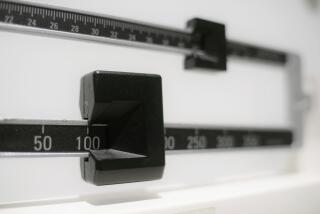Too much on your plate? These dishes may help
Eat what you want -- just don’t eat too much of it. That may be fine advice, but it’s easier said than done. Now a Canadian scientist has conducted a simple study to see if a special set of dishes can help dieters toe the line.
In the first clinical trial on “portion control plates,” Sue Pedersen, an endocrinologist at the University of Calgary, had 65 subjects use a specially designed plate and bowl to limit their calorie intake for part of each day. Another 65 people who didn’t use the dishes served as a control.
Patients in both groups were clinically obese and had Type 2 diabetes, a group for whom losing weight is not just a goal but a medical imperative.
The results, published June 25 in the Archives of Internal Medicine, are encouraging: After six months, subjects using the plates lost an average of 1.8% of their weight, compared with 0.1% loss in the control group. Especially heartening, Pedersen says, is the fact that a subgroup of subjects who were taking insulin did even better -- averaging a loss of 2.5% of weight over six months. Studies show that insulin treatments normally make weight loss more difficult.
Pedersen, a specialist in endocrinology and metabolism, says that aside from selecting patients who weren’t on weight loss medication and who agreed to use the plates, the study was relatively flexible.
For breakfast, subjects used the bowl to measure 200 calories’ worth of cereal and milk -- colored rings on the bowl correspond to different types of cereal -- but only if they wanted cereal. If not, they were free to eat anything else, with no portion restrictions.
The plate, which holds an approximately 800-calorie meal, was to be used during the biggest meal of the day. Its painted lines divvy out sections for grains, cheese, sauce and protein; mixed items such as lasagna were placed in the section that fit their ingredients closest. Vegetables were unlimited as long as they were not covered in oil or fried.
(The dishes, sold by the Diet Plate Limited of England, are not specifically designed for people who are overweight or have diabetes.)
Special plates and bowls can be useful in controlling calorie intake because the notion of an average portion size has changed radically over the years, says Marion Nestle, professor of nutrition, food studies and public health at New York University and author of the 2006 book “What to Eat.”
Research by Nestle and others shows that since the 1980s, the sizes of many ready-made foods -- and the containers manufactured to hold them -- have increased, often two- to fivefold.
Of course, there are other tools that people can use to judge their calorie intake -- such as nutrition labels or the American Cancer Society’s guidance that a 3-ounce serving of meat is “the same size of a deck of cards.” But, Nestle says, studies show people don’t put these aids to good use.
“People don’t have a clue about what they’re eating,” she says. “[They] can be taught but will forget over time.”
Pedersen said she expected the method she studied to work better than abstract ways of controlling portions such as allusions to card decks or advice to “eat meat no bigger than your fist.”
“Who eats off of their hand?” she says. “You don’t eat off of your hand, you eat off of a plate.”
Using the plates had other benefits besides weight loss. By the end of the study, 26% of plate users were prescribed lower doses of hyperglycemia medication (compared with 11% of controls). They also, on average, had their insulin dosages decreased, while those in the control group were more likely to have had their dose increased.
Those using the diet plates also significantly improved cholesterol and triglyceride levels, even though no specific restrictions were placed on fats or oils.
--





